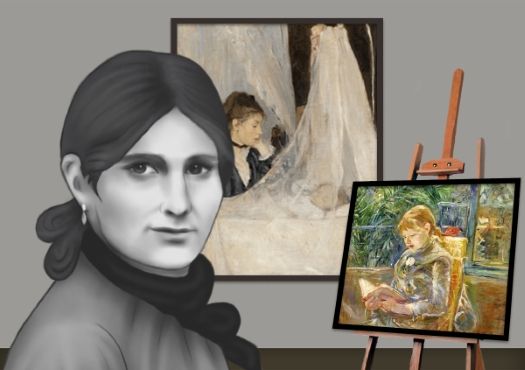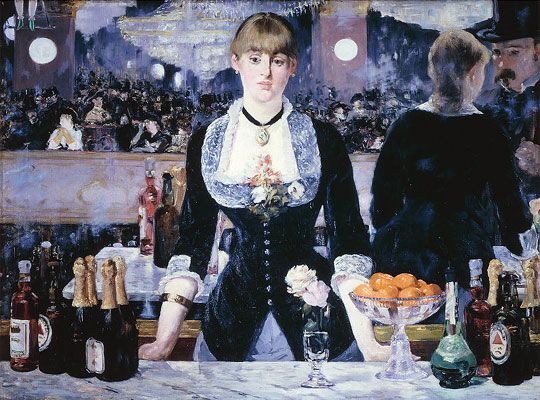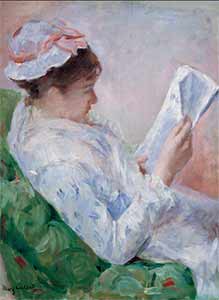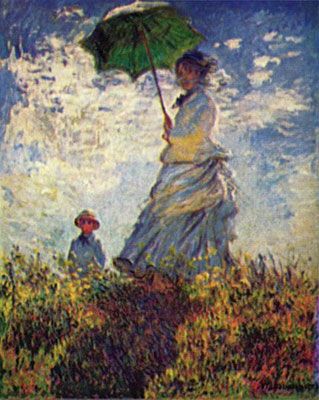Summary of Berthe Morisot
When the second Impressionist exhibition opened in the spring of 1876 in Paris, one sharp-tongued critic described its participants as "five or six lunatics, one of which is a woman." The woman, of course, was Berthe Morisot, who in spite of her gender became a leading figure of the most famous artistic movement of the 19th century. The label of "lunatic," however, was an aberration. Morisot cultivated her artistic talents and achieved success at an early age with acceptance to the Salon at age 23, and tenaciously held on to her rank at the forefront of French painters until her death 30 years later. Though frequently self-critical of her own work, and barred by social conventions from pursuing the same subject matter as her male counterparts, Morisot nonetheless developed the connections and familial support that enabled her to carve out her own independent career as an artist for more than three decades and leave a permanent mark on the direction of French art.
Accomplishments
- Morisot was barred due to her gender from accessing the full range of subject matter otherwise available to her male Impressionist colleagues, particularly the seedier aspects of urban life - cabarets, cafés, bars, and brothels. Conversely, her paintings reveal her access to virtually all aspects of feminine life in the late-19th century, even private, intimate ones that were generally closed to her male counterparts.
- Morisot produced canvases that depicted a wide variety of subjects including landscapes, street and urban scenes, nudes, still life's, and portraits. Like her male colleagues, she too developed favorite models - including her own daughter, Julie - and participated in the artistic exchanges of the period due to her connections within the Impressionist circle and beyond, remaining an innovator in painting up until her death.
- Morisot had the good fortune to not only marry into an artistic family, but also to be wholeheartedly supported by her husband, Eugène Manet (Édouard Manet's younger brother), who sacrificed his own ambition in order to manage her artistic career. She exhibited a keen appreciation of public taste and as a result her works sold well during her lifetime and afterwards. Her talents and skill won her the public respect of her male colleagues as their equal - an achievement that was very uncommon for the times.
Important Art by Berthe Morisot

View of Paris from the Trocadero
This early work is one of the few fully realized landscape works Morisot painted. Completed just after the end of the Franco-Prussian War, the work depicts a view of Paris as a city finally at peace. The view is painted from the top of a hill colloquially known as the Trocadero, today the site of the Palais de Chaillot, overlooking the Seine. Beyond it stretches the Champ-de-Mars, site of the 1867 Exposition Universelle just five years before, which Manet had painted, famously, from nearly the same spot as Morisot does in this work. Now cleared of the massive exhibition buildings, the Champ-de-Mars appears barren and brown, as if its grass has died during the winter. This once-bustling portion of the city, whose fecund fields that showcased industry now lie fallow in Morisot's depictions, mirrors the sort of windswept silence of the larger panorama. The gray sky, opening slightly to a splash of blue at the very top of the canvas, hints at the tumult of the events of the previous five years - the exposition, the war, the fall of Napoleon III's Second Empire, and the Paris Commune - and the notion that the proverbial smoke is, perhaps, finally clearing from Paris in their collective aftermath.
The three figures in the foreground are probably Morisot's sisters Yves and Edma, accompanied by Yves' daughter. They are separated from the cityscape beyond by a dark but porous fence, and the road on which they stand is a dusty beige, likely indicative of the way in which Morisot and her sisters, as bourgeois women, were excluded from the everyday life of the city and from many professional opportunities as artists. As the empty ground on the women's side of the fence suggests, this was not an appealing prospect. The painting gives no suggestion that the very ground of the Trocadero that the women stand on would be massively redeveloped just six years later for the 1878 Exposition Universelle, intended to demonstrate that France, and especially Paris, had recovered from the recent traumatic events.
Oil on canvas - Santa Barbara Museum of Art, Santa Barbara, California, USA
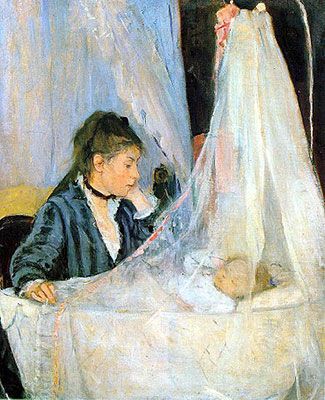
The Cradle
The Cradle is arguably Berthe Morisot's most famous painting. It depicts Morisot's sister Edma gazing down at her daughter Blanche, who is asleep in a cradle behind a gauzy veil. This relatively early work is the first example of Morisot's treatment of the theme of motherhood, which would become a recurring subject in her work, in part due to the era's social limitations placed on women and their ability to explore public places without chaperones. Although the painting was generally admired by critics when it was shown in the first Impressionist exhibition in 1874, Morisot failed to sell it and eventually decided to keep it within her family.
Morisot's painting relies on two interlocking triangles, one encompassing the visible part of Edma's body and the other, slightly taller, formed from the veil, thereby creating a balanced composition which implies a harmony and subconscious link between parent and child. Edma is drawing the translucent curtain closed around the cradle, protecting her daughter from the viewer and emphasizing the private nature of their relationship. The close cropping of the scene (the edges of the cradle itself are eliminated by Morisot's choice of framing) both suggests the privileged nature of the view we have to the scene and invites a comparison with photography, a medium with which the Impressionists were famous for considering. It is difficult to read Edma's expression, however, as there is no direct rapport between her and Blanche, whose eyes are closed. It has been suggested that Edma, who like Berthe painted extensively before her marriage to a naval officer in 1864, appears wistful, seemingly yearning for the time she spent as an artist before settling into the traditional, stable role of motherhood. Thus, just as the veil screens her daughter's form from our clear view, our impressions of her own thoughts remain shrouded in mystery.
Oil on canvas - Musée d'Orsay, Paris
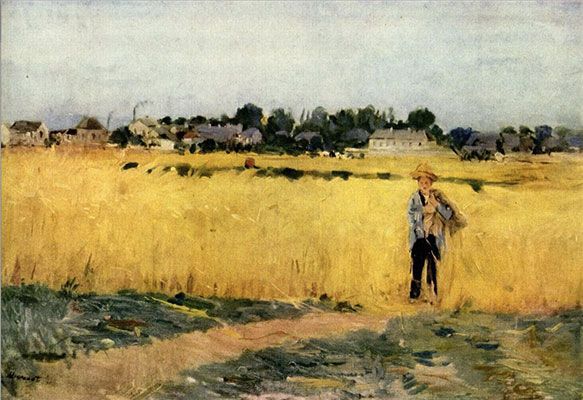
Dans le Blé (In the Wheatfield)
This painting depicts a scene in the village of Gennevilliers, just outside Paris, now a suburb of the French capital, where Morisot's husband's family, the Manets, owned property. The location is typical of that chosen by many Impressionist artists, such as Monet, both as a place to work and for their paintings' subject matter. The painting presents us with a comfortable visual composition of three horizontal zones of color, punctuated by the figure of the young boy to the right of center. The eponymous wheat hints at the traditional farming character of the area, and immediately catches one's attention as it occupies the prime central space on the canvas.
The ears of wheat, however, remain rather indistinct in keeping with Morisot's loose brushwork. Instead, Morisot renders the buildings in the background in slightly sharper detail, revealing in particular the smokestacks of the dirty, sooty factories on the horizon. They act as a reminder of the changing nature of the landscape from agrarian to increasingly industrial, a reminder of the growing city and the disappearance of the virginal rural past in the face of an increasingly modern future. The homely figure with his belongings slung over his shoulder who is emerging in the foreground from the edge of the wheatfield, opposite the factories, arguably represents the archetypal rural villager attempting to escape this inevitable march of industrialization. We might therefore read Morisot's painting as a seductive representation of the countryside and a quiet protest against the transformation of modern life, a theme that is extremely popular among French painters from the Realists to the post-Impressionists.
Oil on canvas - Musée d'Orsay, Paris
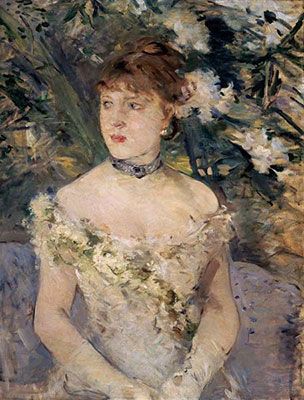
Young Girl in a Ball Gown
This depiction of an unknown young woman in a ball dress demonstrates the range of Morisot's work. It is highly dynamic, a sense created through the loosely defined floral background that is echoed in the trimmings of the woman's dress. Peter J. Gärtner argues that this background is a key element of the work, claiming that "the dense vegetation shuts out the external world and protects the young woman's youthful beauty and innocence." It also provides the viewer with a more intimate connection with the sitter, implying that most other viewers are excluded by the painting's enclosed background and tight angle. The lengthy, unkempt brushwork is typical of Morisot's work from the late 1870s, which, as Nathalia Brodskaia has noticed, created a "vibration of color and light" previously unseen in her paintings.
Morisot's work invites comparison with her fellow Impressionist Mary Cassatt's Woman with a Pearl Necklace in a Loge, painted in exactly the same year, 1879. In Cassatt's painting, a similarly formally dressed woman is positioned in an upper-level box at the Paris Opera, a prime social venue for observing others and simultaneously being seen. Cassatt's work explores the liminal nature of public vs. private space and the opportunity for 19th-century women to command a public persona. The women in both of these paintings are seated, but while Cassatt's subject appears self-confident and relaxed in a clearly identified setting, Morisot's figure appears somewhat apprehensive and distracted, as if she is waiting for someone before departing the unknown event she is attending. The dynamic brushwork here arguably underscores the unclear nature of both her thoughts and the overall scene.
Oil on canvas - Musée d'Orsay, Paris
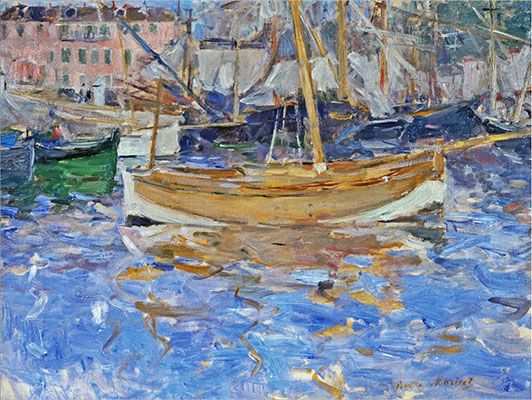
The Harbor at Nice
Although Morisot is frequently associated with interior or domestic scenes, her work spans a great variety of genres, like the other members of the Impressionist circle. This painting, from the height of the Impressionist era, depicts a cluster of boats docked in the eponymous port in the south of France on the Mediterranean, where Morisot and her family were wintering in 1881-82. It uses an unusually bright palette, and begs comparison with other seminal Impressionist works, including the movement's foundational work, Monet's Impression, Sunrise (1872), which similarly takes a harbor scene as its subject matter.
Like Monet, Morisot is concerned with the effects of natural light as it falls on the surfaces of the boats and the water. She has shifted the field of vision down from the predictable snapshot that would include more of the sky, the rooftops, and the pinnacles of the ships' masts. Instead, Morisot crops most of these elements out of the frame to concentrate on the contrast between the brown and white hull of the boat at the center and the water - which, through its reflection, cleverly reveals the fair weather in the blue sky that has been omitted from the opposite edge of the painting.
Morisot's work here is also innovative as it forecasts that of the Post-Impressionists such as Cézanne and especially Seurat and van Gogh by its emphasis on the juxtaposition of the different regions of color using abbreviated, loose brushwork to achieve a more luminous effect. As a result, the regions of strong color - the water, the hulls, the masts, and even the pink building at the back left - appear as more brilliant, prominent elements within the work than they might with a smoother, more homogenous application of color.
Oil on canvas - Private Collection
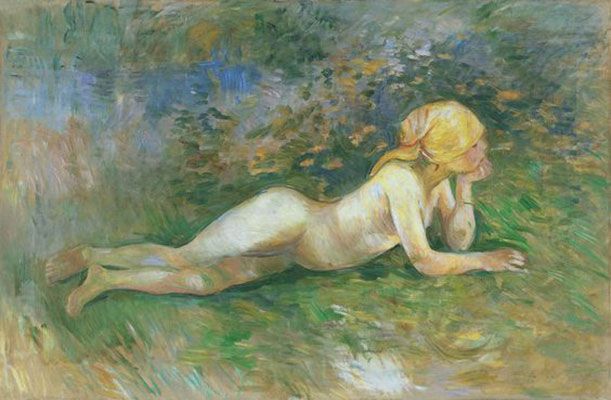
Reclining Nude Shepherdess
This painting is typical of Berthe Morisot's later work, which uses a bright color palette, marked by contrasts between orange, violet and green hues, in contrast to the muted range of colors that she preferred during the 1870s. This is one of several compositions from the early 1890s, which feature a reclining shepherdess, modeled on a young girl from a local village outside Paris. She posed her model nude except for a characteristic headdress, an unusual choice for a female artist at the time.
The landscape behind the figure is depicted in a very loose, semi-representational style, which echoes contemporary work by artists such as Monet. Morisot's treatment of the nude figure, however, owes much more to the style of Renoir, whose female nudes Morisot admired and who visited Morisot and her family during this period, which might account for his influence here. The lines of the subject's body are compact and clearly defined, both through the use of flesh tones and in the shadows, which follow the figure's contours. This can particularly be seen in the curve of the back and the definition of the limbs. However, as some scholars have noted, there no parallel pose of the nude in either Renoir's own work nor in that of Degas, whose nudes Morisot was also known to have admired. Instead, it is a key example of the way that Morisot continuously remained in dialogue with current trends, producing her own style that did not merely develop in imitation of other artists.
Oil on canvas - Museo Thyssen, Madrid
Biography of Berthe Morisot
Childhood
Berthe Morisot was born to Edmé Tiburce Morisot and Marie-Joséphine-Cornélie Thomas in Bourges, France, in 1841. The family was well-off and her father worked as a senior administrator for the local government. Her mother was related to the Rococo painter Jean-Honore Fragonard. Morisot had two older sisters, Yves and Edma, and also a younger brother Tiburce. In 1852, the family moved to Paris, where Morisot would live for the rest of her life.
As the daughters of a bourgeois family, it was expected that Berthe and her sisters would receive an artistic education. The painter Joseph Guichard, one of their private tutors, took them to the Louvre, where he taught them to learn by copying the paintings on the walls. Guichard notably warned the girls' parents that continuing their artistic education could be problematic: "Given your daughters' natural gifts, it will not be petty drawing-room talents that my instruction will achieve; they will become painters. Are you fully aware of what that means? It will be revolutionary - I would almost say catastrophic - in your haute bourgeoisie milieu."
However, Edma and Berthe continued to be taught even after this warning. After a while, however, Edma married a naval officer and moved away to have children, meaning she gave up her serious artistic pursuits. But, she did continue to encourage Berthe (with whom she was very close) to continue working.
Early Training and work
Morisot responded by registering as a copyist at the Louvre. When she was there, she got to know other artists including the landscape painter Jean-Baptiste-Camille Corot. He encouraged her to start working en plein air, where she began to produce her first serious paintings. She studied painting extensively during this period, and was also taught sculpture, although none of her sculptural works survived.
In 1864, when Morisot was only 23, the official Parisian Salon accepted two of her landscape paintings. As a young woman, this was an almost-unheard-of achievement. One critic responded by saying, "You see, ladies, one may be an artist and take part in public exhibitions of painting and remain, as before, a very respectable and very charming person." She continued to show at the Salon for several years, where her work was generally well-received.
Mature Period
In 1868, Morisot met the effective leader of avant-garde painting in Paris, Édouard Manet. Manet famously wrote in a letter to Henri Fantin-Latour, "the [two sisters] Morisot are delightful. What a shame they aren't men; nonetheless they might, as women, serve the cause of painting by each marrying an academicien" (men who were jurors of the French Academy). Manet and Morisot immediately became quite close, and began to provide feedback on each other's work. Professionally however, Morisot was upset when Manet made his own additions to one of her Salon submissions more nonchalantly than Morisot desired, suggesting that Manet didn't see the relationship as wholly reciprocal.
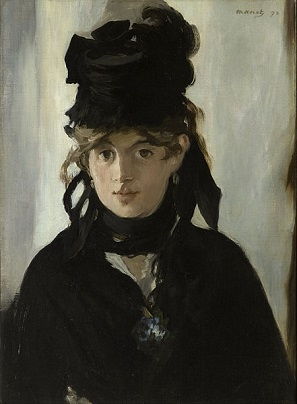
Nonetheless, Manet evidently respected Morisot's opinion and work as an artist. Notably, Morisot prompted Manet to take up en plein air painting, which was a significant move in his artistic practice. Manet painted Morisot 12 times, making her his most frequent subject. He completed a particularly famous portrait of Morisot in 1872, where he depicted her wearing a black dress, with a confident, intelligent gaze. According to critic Sue Roe, Manet's 1868 work The Balcony depicts Morisot and "focused on her air of compelling beauty, her mystery and the complex inner struggle reflected in her face."
It has been suggested that the pair were romantically involved, but couldn't pursue a relationship as Manet was already married by the time they met. It stands to remember that Manet was quite the playboy of his time, regularly attending brothels and reportedly keeping company with many women outside of his marriage. Whether the two had a passionate affair, or Morisot was the exception to Manet's supposed habits, is unknown. Through the letters left by Morisot we do know she cared deeply for the charismatic Manet.
In 1872, Morisot sold 22 paintings to the private dealer Durand-Ruel, marking the start of her career as an established artist. Through her connection with Manet, Morisot was drawn into his circle of painters who were later known as the Impressionists. Manet himself refused to leave his more traditional art career and encouraged Morisot not to join the avant-garde group. However, Morisot didn't take his advice and her work was included in the first ever exhibition of Impressionist painting in 1874, pointing to her importance within the growing movement.
Morisot's skill at gauging public taste is suggested by the fact that her work remained popular throughout her lifetime and she often outsold many of her contemporaries, including Edgar Degas (who was a frequent visitor at her family home, and is thought to compete with Manet for her attention), Claude Monet, and Alfred Sisley. However, she was unrelentingly critical of herself and her own work. In a letter to Claude Monet, for example, she accused herself of "becoming a bronchial old lady...engaged in a war with my canvases. Do not depend on me to cover much wall space. I am not doing anything worthwhile despite my desire to do it."
In 1874, and at the relatively late age of 33, Morisot married Manet's younger brother Eugène. Some have suggested that theirs was a marriage of convenience, a second-best option when Morisot couldn't marry the older, already-married artist. Eugène was also an artist, but he agreed to give up his own career in order to help Morisot in hers. Upon their marriage, Edgar Degas gifted the couple a portrait of Eugène. Manet never again painted Morisot after the marriage.
Late Period
Unlike her sister, Morisot continued to paint while also carving out a life as a wife and a mother. In 1878, she and Eugène welcomed their first and only child, Julie. Morisot frequently painted her daughter, and as a child Julie also posed for several other painters such as Manet and Renoir.
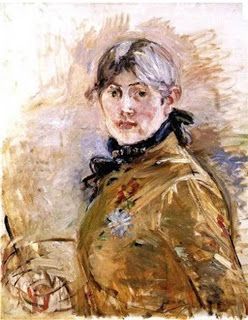
Throughout her career, Morisot had close friendships with many members of the Impressionist circle, including Degas, Monet, Renoir, and the poet Mallarme. She continued to be actively involved in the Impressionist group, exhibiting with them every year except 1878. She even organized the final Impressionist exhibition in 1886 entirely single-handedly. After the demise of the Impressionist group as an organized movement she continued to exhibit with avant-garde artists, contributing several works to the Belgian group Les XX's show in Brussels in 1887 and four paintings in 1894 to that of its successor, La Libre Esthetique. Unusually, Morisot always exhibited under her maiden name instead of using a pseudonym or her married name.
Eugène Manet suffered from a period of poor health beginning in 1891 and finally died in Paris the following year. Three years later, their daughter Julie contracted pneumonia. Morisot nursed her back to health, but sadly picked up the illness herself and eventually died on March 2, 1895. After her death the poet Paul Valery wrote that "Berthe Morisot's uniqueness was to 'live' her painting, and to paint her life [...] she took up, put down, returned to her brush like a thought that comes to us, is clean forgotten, then occurs to us once again."
The year after her death, Morisot's artist friends, including Degas, Renoir, Monet and Mallarme, organized the first retrospective of Morisot's work, drawing together 380 of her paintings and paying tribute to her talent.
The Legacy of Berthe Morisot
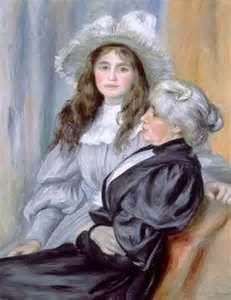
Throughout her career, Berthe Morisot had to fight against preconceptions of women and their role. She was highly unusual in her decision to be an artist as well as a wife and mother, but many people inevitably saw her primarily in her traditionally female roles. Therefore, until recently it has been assumed that Manet was the "master" and Morisot the "student" in their relationship, but it is certainly arguable that they influenced each other in different ways.
Although she has been forgotten in some corners, Morisot was an important figure in the founding of Impressionism as a movement; she participated in their first exhibition and was a key artistic and social figure within their circle. Morisot was also a strong encouraging influence on other female Impressionist painters living in Paris at the time, such as Mary Cassatt and Eva Gonzalès.
Influences and Connections

Useful Resources on Berthe Morisot
- Berthe MorisotOur PickBy Jean-Dominique Rey
- Berthe Morisot: The First Lady of ImpressionismOur PickBy Margaret Shennan
- Women Impressionists: Berthe Morisot, Mary Cassatt, Eva Gonzalès, Marie BracquemondBy Max Hollein (editor)
- Berthe Morisot: A BiographyBy Anne Higonnet
